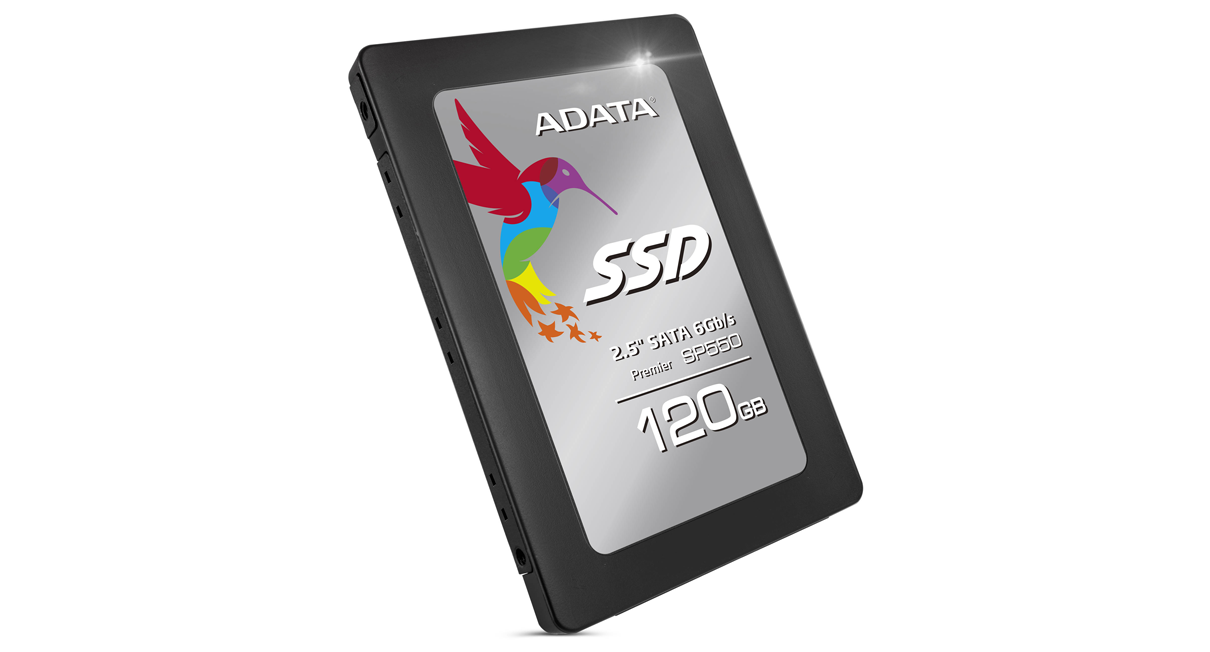Solid state drives are great. Due to their, ehem, solid nature—they have no moving parts unlike a hard disk drive—they are able to access data much faster, leading to quicker boot times, app startup, and generally better overall performance. But obviously, there’s a caveat: an SSD’s price per gigabyte is almost 1,000 percent more than an HDD’s. Nothing comes free after all, but there’s such a thing as bang for the buck. Today, we’ll take a look at the 120 GB Adata SP550, an SSD with an easy-to-swallow cost and performance that promises to not disappoint.
Specifications:
- Capacity: 120, 240, 480, and 960 GB
- Rated Performance: Up to 560 MB/s read speed; up to 510 MB/s write speed
- Form Factor: 2.5 inch
- NAND Flash: SK Hynix 16 nm TLC
- Controller: Silicon Motion SM2256
- Dimensions: 100.45 x 69.85 x 7mm; 47.5 g
- Interface: SATA 6 Gb/S
- Shock Resistance: 1500 G/0.5 ms
- Mean Time Before Failure: 1,500,000 hours
- Warranty: Three years
Design: 4/5
It’s an SSD. As long as all the memory chips inside are covered by a solid case, I’m good. I really don’t care whether the body itself is covered in lame stickers, or finished in an awful paintjob. You won’t really be seeing it inside your machine anyway, so who cares how it looks? What counts is that it works and it works well.
Honestly speaking though, I consider it a bonus that the Adata Premier SP550 looks pretty good. It’s mostly black, with a huge area on the top covered by an Adata sticker containing the model, capacity, and interface; while the bottom has all the manufacturing codes.
It’s also thin at 7 mm, that, along with the bundled 2.5 mm spacer, allows it to fit snugly in most notebooks and ultrabooks, but not the ultrathins manufacturers are chucking out today.
Hardware: 4/5
Although the 240, 480, and 960 GB versions of the Premiere SP550 boast higher rated write speeds at up to 510 MB/s for the first two and up to 490 MB/s for the last one, our 120 GB review unit only goes up to 410 MB/s in the write department. However, it can take comfort in the fact that it’s faster than the 960 GB variant in read speed, coming in at 560 MB/s versus 520 MB/s.
Driving the performance is Silicon Motion’s SM2256 memory controller paired with SK Hynix 16 nm TLC NAND flash chips and 128 MB of Samsung cache memory . The combo results in a drive that’s priced very competitively—it’s actually one of the lowest priced SSDs I found online. The high quality components can also explain the drive’s 1,500,000 hours mean time before failure and lengthy three year warranty.
User Experience: 4/5
After installing the 120 GB Adata Premier SP550 in a computer and installing Windows 8.1, I immediately filled the drive almost to the brim, leaving under 7 GB of space available. It’s been documented that SSDs slow down significantly the fuller they are, so the test environment is pretty much worst case scenario for the drive’s performance.
Still though, booting up, loading files, and opening applications is still much faster on the SP550 than on an HDD. Even reading and writing files seemed significantly quicker, with a 26 GB file transferred over USB 3.0 to the drive finishing in no time at all. If you’re coming purely from a platter drive standpoint, you’ll be blown away with the SSD experience. Trust me.
Benchmarking the drive confirms that it doesn’t stray too far away from its advertised speeds even when full. Using the CrystalDiskMark Q32T1 Sequential and 4K tests, the Adata Premier SP550 managed a Sequential rating of 558.6 MB/s and 362.3 MB/s in the read and write departments, respectively; and a 4K score of 293.7 MB/s and 303.5 MB/s in read and write, respectively. Those numbers are pretty impressive for something so cheap.
Value: 5/5
While the Adata Premier SP550’s performance is par for SSDs, it’s priced significantly less than those with a similar capacity. And that’s okay. It’s not meant to be in an enthusiast’s rig; rather, it’s meant to introduce those transitioning from hard drives to the wonderful world of flash memory. It’s also great for giving a new lease on life on aging systems, whether they be a desktop or a laptop. For me, it’s money well spent.
What’s Hot:
- Great value for money
- One of the most affordable SSDs
What’s Not:
- Definitely not the fastest
Bottomline:
- Get this one; be happy.
Final Score: 17/20
